Rest and Recovery for Working Dogs
Working dogs are remarkable athletes. Whether they’re out in the field during hunting season, competing in agility trials, diving off docks, or providing life-changing service and therapy work, these dogs give everything they have to the tasks before them. Their drive, stamina, and focus are what make them such valuable partners—but they also make rest and recovery absolutely essential.
Just like human athletes, high-energy dogs need intentional downtime to repair their bodies, reset their minds, and prepare for the next challenge. Without proper recovery, they can become overworked, risking injury, burnout, or long-term health issues. Understanding how to balance work with rest is key to ensuring your dog’s well-being and extending their working career.
Why Rest Matters for Working Dogs
Many high-drive dogs don’t naturally slow down. Their eagerness to perform means they’ll keep running, retrieving, or working long after fatigue sets in. While this determination is admirable, it can also be dangerous if handlers don’t step in to set limits. Studies on working dogs show that rest plays a critical role in both physical repair and emotional balance, helping to regulate hormones and strengthen joints (Brady et al., 2021).
Rest allows muscles to repair microscopic tears caused by strenuous activity, strengthens tendons and joints, and reduces inflammation. Equally important, downtime helps regulate hormones, boost the immune system, and maintain mental balance. For dogs who thrive on training and stimulation, structured rest prevents them from tipping into overstimulation and stress.
Think of your dog like an elite athlete: training builds skill, but recovery sustains performance.
Signs Your Dog Needs Rest
Research with working dogs has shown that even elite canine athletes experience noticeable behavioral and activity changes when they need recovery time (Rundgren et al., 2021). Because dogs can’t verbalize their fatigue, it’s up to owners to recognize the cues. Some common signs include:
Physical fatigue: stiffness after activity, limping, slower gait, or hesitation before jumping or retrieving.
Behavioral changes: irritability, restlessness, lack of focus, or resistance to commands they usually follow.
Subtle signs: increased sleeping during the day, disinterest in play, or lying down more quickly after exertion.
Paying attention to these signals allows you to intervene early, giving your dog the time they need to recover before small issues turn into injuries.
The Role of Sleep
Sleep is the foundation of recovery. Most dogs require 12–14 hours of rest per day, and high-energy breeds often benefit from even more, especially after intense training or long hunts (Bunford et al., 2020). Puppies and senior dogs may need up to 18–20 hours.
During deep sleep, a dog’s body releases growth hormones that repair tissues and build strength. Sleep also consolidates learning, helping dogs retain training commands and sharpen problem-solving skills.
Owners can support quality rest by providing a quiet, comfortable space where their dog feels safe and undisturbed. A soft bed in a low-traffic area of the house or a crate with proper padding encourages restorative sleep, which is just as important as exercise in keeping a working dog healthy.
Active Recovery
Rest doesn’t always mean complete inactivity. Many working dogs benefit from active recovery, which involves low-intensity movement to keep muscles loose without stressing the body (Watson et al., 2017).
Examples include:
Gentle walks: slower-paced strolls to promote circulation.
Swimming: a low-impact exercise that builds endurance while easing stress on joints.
Stretching and massage: simple movements and light massage can ease stiffness and improve flexibility.
Active recovery is especially valuable during hunting or competition season when dogs may have several high-demand days in a row. Short, light activities between sessions help prevent soreness while still giving them a mental outlet.
Mental Recovery
High-energy dogs don’t just work their bodies—they work their minds. Activities like tracking, agility, or service work require focus and problem-solving, which can be mentally exhausting (Travain et al., 2024).. Without mental recovery, dogs may show signs of stress, anxiety, or irritability.
Handlers can encourage mental rest by:
Providing enrichment that doesn’t tax the body: puzzle toys, scent-based games, or slow feeding challenges.
Building calm routines: grooming sessions, cuddling, or crate downtime offer soothing structure.
Keeping stimulation balanced: alternating high-intensity training with quiet bonding time ensures dogs don’t burn out.
Just as humans need a break from constant work, dogs benefit from moments of calm that recharge their mental resilience.
Preventing Overtraining
It’s tempting to push a hard-working dog to train every day, but overtraining can do more harm than good (DogBase, 2024). Scheduling rest days is crucial. Instead of daily high-intensity work, alternate between challenging sessions and lighter activities.
During hunting season, for example, dogs may work back-to-back long days. Building in rest before and after those stretches helps prevent fatigue-related mistakes in the field and keeps performance consistent.
Handlers should also remember that recovery needs vary by age and breed. Young dogs may bounce back quickly, while older dogs require more deliberate rest. Tailoring rest schedules to your dog’s specific needs ensures a healthy balance.
A dog’s working career is a marathon, not a sprint. Prioritizing rest and recovery can extend their ability to work at peak levels for years. It also reduces the risk of chronic issues like joint damage, ligament tears, or stress-related behavioral problems.
Working dogs give everything they have—often more than we realize. Their drive, loyalty, and athleticism make them extraordinary partners, but they rely on us to safeguard their health. Rest and recovery aren’t signs of weakness; they are essential elements of a strong training program.
By recognizing the need for downtime, encouraging quality sleep, incorporating active and mental recovery, and preventing overtraining, you give your dog the tools they need to thrive. In doing so, you strengthen not only their performance but also the bond you share.
References:
· Brady, K., Cracknell, N., Zulch, H., & Mills, D. S. (2021). The animal welfare science of working dogs: Current perspectives on recent advances and future directions. Animals Journal
· Rundgren, M., DuBois, C., Stenlund, T., & Axelsson, J. (2021). Changes in behaviour and voluntary physical activity exhibited by sled dogs throughout incremental exercise conditioning and intermittent rest days. Animals Journal
· Bunford, N., Kis, A., Miklósi, Á., & Gácsi, M. (2020). Sleep in the dog: Comparative, behavioural and translational relevance. Neuroscience & Biobehavioral Reviews
· Watson, P. F., Otto, C. M., & Cobb, M. L. (2017). Environmental and physiological factors associated with stamina in working dogs: A review. Frontiers in Veterinary Science
· Travain, T., et al. (2024). Evaluation of indicators of acute emotional states in dogs. Scientific Reports
· DogBase. (2024). Fitness and conditioning for working dogs: How to build endurance and strength. DogBase Blog






















